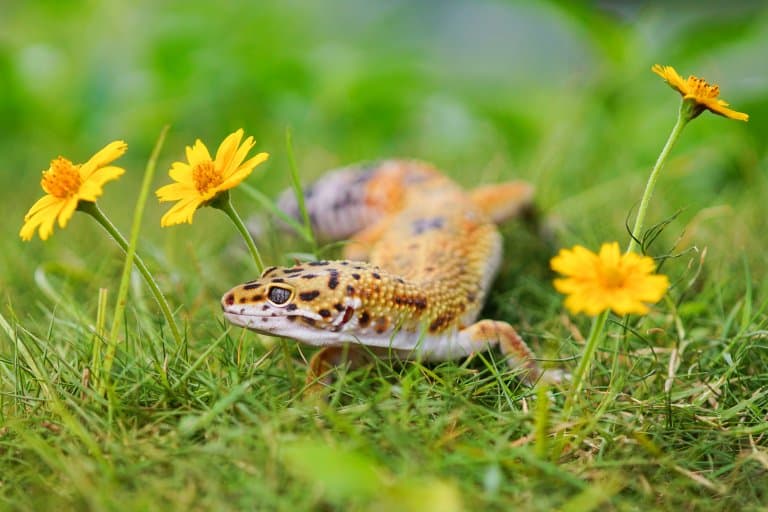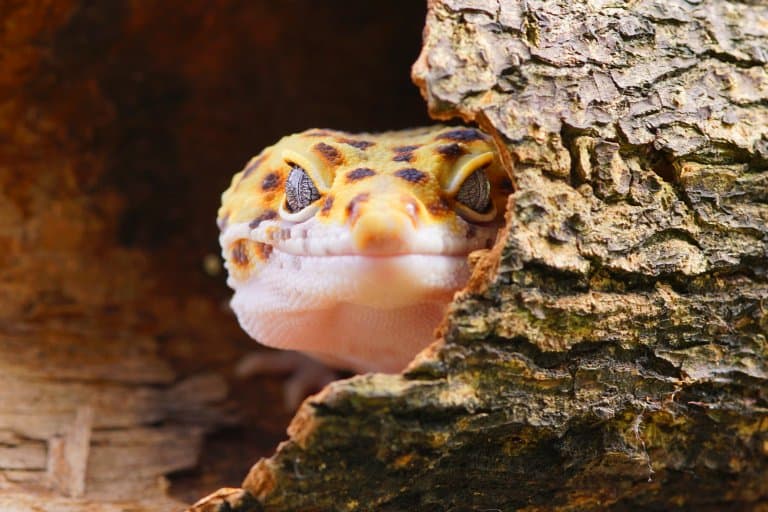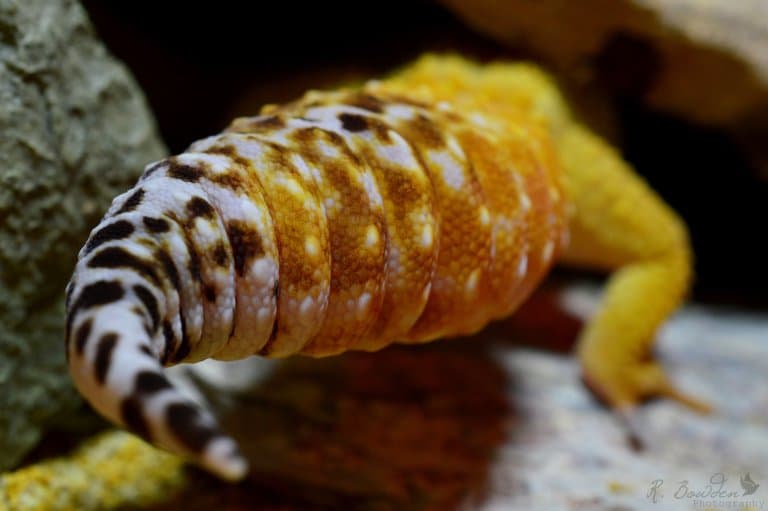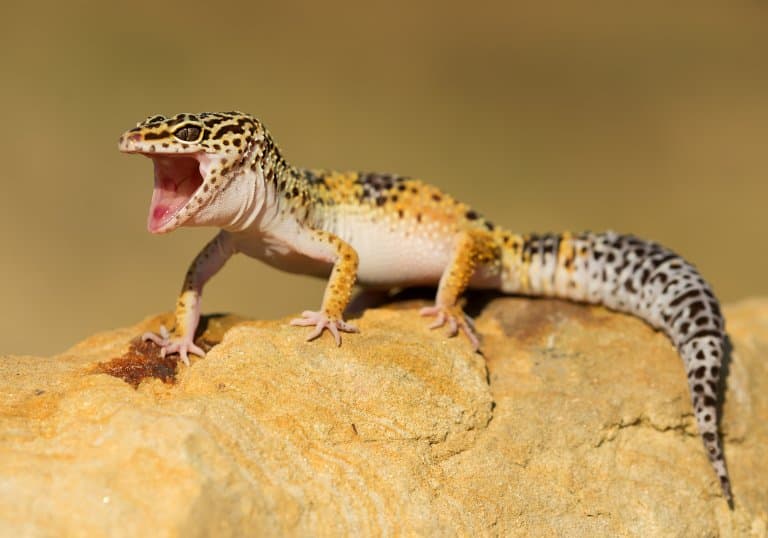Leopard Gecko Profile
Geckos are better known for being slender, beige little things sitting under lamps catching moths, but not all are master climbers, some are brightly coloured, terrestrial and really quite big.
Leopard geckos are all of these things and more, and are of great interest to collectors and researchers alike.
Also known as the ‘common leopard gecko’, this ground-dwelling lizard species is native to deserts and shrublands of south-Asian Afghanistan, Iran, Pakistan, India, and Nepal.

Leopard Gecko Facts Overview
| Habitat: | Forest, Shrubland |
| Location: | India, Afghanistan, Pakistan |
| Lifespan: | 15 years |
| Size: | 28cm (11inches) long |
| Weight: | 80g (2.8oz) |
| Colour: | Diverse, patterned, usually with yellow-brown base tones with black spots |
| Diet: | Mostly invertebrates, some small vertebrates |
| Predators: | Foxes, snakes, small mammals |
| Top Speed: | unknown |
| No. of Species: | 1 |
| Conservation Status: | Least Concern (IUCN) |
Leopard geckos inhabit rocky, dry grasslands and desert regions with little vegetation. They can also be found in arid forests and will use rocks and loose tree bark to shelter under.
They are nocturnal creatures in the wild, and sleep in underground burrows during the day. From dusk, they will diet on insects, as well as small vertebrates such as mice pups, and smaller reptiles.
Leopard geckos are one of the largest species of gecko and come in a variety of flavours, with 5 subspecies. But they all have multiple awesome attributes in common. They can talk, they can blink, and they can even follow your gaze.
They also have some impressive regeneration abilities and a bizarre tail that can serve many purposes. Read on for our favourite facts.
Interesting Leopard Gecko Facts
1. Their name is derived from their skin
The skin of these incredible geckos contains xanthophores (yellow) and melanophores (black spots), which resemble a leopard from which their name is derived.
They can range in color from yellow to brownish-orange base.
Their scientific name ‘macularius’ refers to the Latin word macula meaning ‘spot’, in reference to their spotted markings.

2. They have vocal cords
This is weird. Not only for an animal this small but for lizards in general. Lizards aren’t supposed to be able to scream, but leopard geckos can, and do, and it’s very effective at making you think twice about picking one up.
These feisty little lizards even appear to leave the egg quite furious.
And perhaps you would, too. Entering the world alone, suddenly enveloped by endless space, and prodded at by an overbearing herpetologist, it’s no wonder that they are quick to use their voice.
Geckos are the only lizards to have vocal cords, and this does lead to surprising discoveries. Not only of the little lizard shouting at you from underneath the lamp but also of a deeper level of acoustic communication than we might have assumed. 1 2
3. They might have vocal plasticity
If you’ve ever been in a loud room and had to raise your voice to get your message across, you’ve exhibited vocal plasticity. This is so common we don’t even think about it, but it’s not a universal skill in all noisy animals.
A cricket will make the same noise, regardless of what’s going on around it. If the environment gets too loud, its call gets drowned out and there’s nothing that it can do.
Birds and mammals, though, have evolved to adjust their acoustic communication in response to changes in social or physical environments. This is something that was only recently discovered in reptiles – in a gecko species (though it was in one of the other 124 genera of gecko known to science).
Still, it opens the door for further research into these vocal little reptiles and hints at a more complex vocal communication system than we’d been giving them credit for. 3
4. Leopard geckos have eyelids
This is another thing you might take for granted, and hopefully, so do you. But in geckos, it’s not so common.
Most species have a glassy lens over the eye, and this gets seductively cleaned by the animal’s long and sticky tongue. But leopards are more classy than this, and have a matching pair of lids, as well as a sideways closing lid for triple protection.

5. They can use their tail as a decoy
These are not the characteristically sleek and smooth little lizards you associate with the gecko heritage. Leopards are a far cry from common house geckos both in taxonomy and appearance.
They’re a lumpy bunch with bulging eyes and their tails are more like clubs than whips. But even this strange appendage is pretty amazing.
It’s a fat-storage lump, and as such gives important clues as to the condition of the lizard. A nice plump tail suggests it won’t need to eat for a while and has access to plenty of resources.
But more than this, it’s also a mock head. Much like many animals have eyespots on their wings to distract predators from their vulnerable heads (or sometimes to mimic a much more dangerous animal), the tail of a leopard gecko is used as a defensive decoy.
It can be waved around menacingly in the presence of the threat, and if push comes to shove, it can even detach and wiggle around distractingly as the rest of the animal makes its escape. This control over their tail is called caudal autonomy. 4
6. Their tail grows back
Regenerative medicine is all about gecko tails. In some vertebrates – mostly amphibians and some lizards – there’s a genetic ability to re-grow appendages that sounds very appealing.
Leopard geckos are one of these animals and some of the fastest to do it. When a leopard gecko loses its tail, a replacement isn’t far away.
In 30 days, a leopard gecko can have a brand-new tail, and some think they hold the key to modifying our own human genes to turn this ability back on. Curiously, the regenerated tail is even better than its predecessor, containing more fat storage and generally becoming larger than the original.
As humans, we still have a bit of this – the very extreme end of our fingers can grow back up to the first digit if removed, and figuring out the genes responsible for this process isn’t entirely far-fetched.
Some of the stem cells responsible for growing the new spinal cord in leopard geckos have now been isolated and studied, and perhaps one day we’ll have leopard gecko injections at our disposal to heal spinal injuries. 5

7. Are they cannibals?
Sometimes the person you can least trust to tell you about an animal is the one who works the closest with it.
Cat owners are the worst when it comes to misrepresenting their animals’ behaviour, but it also happens that qualified gorilla trainers, parrot behaviourists dolphin biologists, and any number of other researchers intimately involved with their subjects have published dubious works that are seemingly impossible to replicate.
So, when the leopard gecko community assures you that cannibalism only happens between adult Leos and their young when they’re malnourished or underfed, you can afford to be sceptical.
We do know that in some cases, an adult or even another juvenile will eat baby geckos. We don’t know if this is common or not, yet. 6
8. They can’t climb walls
One of the best things about being a gecko is the phenomenal textured toes that come as standard on most models. This allows them to climb almost any surface except Teflon and is the basis for numerous materials science studies.
These miraculous feet aren’t sticky but are covered in microscopic hairs that allow them to scale walls and fight each other over moths above your head.
But leopard geckos have none of this; they spent their character points on the extra eyelids. So, they’re not very good at climbing at all. This might be why they’re so grumpy when they hatch.
As terrestrial lizards though, they do manage quite well without arboreal adaptations.
9. They’re easy to breed
This is literally a lifesaver for the species, considering it only occupies a small portion of the globe and is one of the most popular exotic pets there is.
Leopard geckos are hugely popular in the herp world, and there are likely more captive examples than wild ones. Their ease of breeding makes it a simple matter to supply the demand without needing to harvest from wild populations.
10. Leopard geckos continually replace their teeth
Leopard geckos are ‘polyphyodonts’, which is an animal whose teeth are continually replaced. Other examples are other other reptiles, crocodiles, and some toothed fish.
Leopard geckos have 100 tiny teeth and they are replaced every 3-4 months. They have a small replacement tooth next to each full grown tooth ready and waiting!
These tiny teeth are conically shaped and are on both the the upper and lower jaws – but are barely visible! Squint and you might just be able to see them.
They are so tiny, they are generally unable to piece the skin of a person, and therefore are safe to handle and one of the reasons they are such popular pets.

11. They semi-hibernate in the wild
Winter temperatures can reach below below 10 °C (50 °F) in regions that the leopard gecko occupies in the wild, which forces them into underground semi-hibernation.
This dormant state is known as ‘brumation’. They will begin brumation in late autumn as temperates drop, and wake up often to drink water, before going back to sleep.
They can go for months without food, living off their stored fat reserves.
12. They might know what you’re looking at
Sometimes, a significant discovery hits too quietly to notice, and in reptile research, some may have identified something that’s far greater than it sounds.
Gaze-following is an advanced cognitive ability and yet another thing we take for granted: if mid-sentence, your conversation partner stops talking and looks over your shoulder, you’d do well to turn around and see what they’re looking at.
But this seemingly simple act implies a lot about your social abilities at the base level. In short, this is very much a central skill that has evolved as a gather social information.
Gaze-following was reported in 2017 in bearded dragons, and even in tortoises in 2010, but in 2018, leopard geckos were added to the list of asocial reptiles with the ability to read each other’s intentions.
This, like the vocal range, adds to the growing body of evidence that reptiles can be far more complex and intelligent than we want to believe. 7
Leopard Gecko Fact-File Summary
Scientific Classification
| Kingdom: | Animalia |
| Phylum: | Chordata |
| Class: | Reptilia |
| Order: | Squamata |
| Family: | Eublepharidae |
| Genus: | Eublepharis |
| Species: | Eublepharis Macularius |
Fact Sources & References
- GeckoTronix (2017), “Angry Gecko Hatchlings”, YouTube.
- Adventures of Evangeline & Willow (2011), “Gecko Scream”, YouTube.
- Henrik Brumm (2017), “Vocal plasticity in a reptile”, NIH.
- Anthony P. Russell (2015), “The regenerated tail of juvenile leopard geckos (Gekkota: Eublepharidae: Eublepharis macularius) preferentially stores more fat than the original”, Science Direct.
- “U of G Study First to Identify Cells Driving Gecko’s Ability to Regrow Its Tail”, University of Guelph.
- R. Bonke (2011), “A remarkable case of cannibalism in juvenile leopard geckos, Eublepharis macularius”, Research Gate.
- Anim Cogn (2019), “Gaze following in an asocial reptile (Eublepharis macularius)”, NIH.
